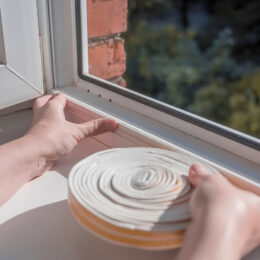
Bartholomew County REMC consumer Jay Shoaf stands by his backyard wind turbine — in more ways than one. Though the Hope grain farmer knew the residential-sized turbine would hardly make a dent in his energy use, he says he’s glad he has it and is doing something in terms of self-reliance and energy independence. Photo by Richard G. Biever
Tilt toward wind turbines needs to be more than a monetary quest
Bartholomew County grain farmer Jay Shoaf could hardly be confused with Don Quixote, the retired country gentleman of 17th century Spanish literature. To make better the world, Quixote, the story goes, set aside sanity to become an idealistic “knight-errant,” and wound up jousting with windmills he thought were giants.
But some folks might say Shoaf’s own tilt toward windmills — a three-bladed electricity-generating turbine he erected on the hillside beside his home and fields — is a tad quixotic … as in “impractical.”
The difference: Shoaf had no lofty aspirations for his project and hasn’t been disillusioned by the results.
When Shoaf bought the 2.4 kilowatt turbine two summers ago, he knew he’d never generate much power as payback. True to the site evaluation he received, the turbine generates just 200 to 300 kilowatt-hours during the best of months. That’s only about what the average Hoosier household uses each week. Since he receives less than a dime per kWh for his power, “payback” might not be the most accurate word to use. For Shoaf, unlike a lot of folks newly interested in producing their own electricity, seeing green wasn’t his motivation for going green.
“I didn’t do it to get my money back,” he said. “To go green is going to cost money; you’re not going to be cheaper than oil, unless oil goes up. If it comes down to dollars and cents, it can’t compete — unless you’re trying to be self sustaining a little more.”
Being more self sustaining was his goal.
Oil prices spiked that summer of 2008. Shoaf, who farms about 1,200 acres, saw his fuel bill double. He said he was tired of seeing some of his money go to the already incredibly wealthy in the Mideast. So he converted all of his farm vehicles from gas and diesel to use homegrown fuels like ethanol and biodiesel. Then, the Bartholomew County REMC consumer started looking at the ways he used electricity at his home and farm.
He and his wife, Nancy, did some basic efficiency improvements in the home, and he looked at adding the wind turbine. Mostly, he said, he was just curious to see how feasible it was. And, he wanted the peace of mind that he could generate some of his own energy. “It made me feel good to do something,” he said.
Wind in the wires
Like Shoaf, more and more people are attracted to the idea of generating their own electric power through the use of “backyard” renewable energy systems. Small wind turbines are one of the most popular choices, but careful study and assistance from your electric cooperative can ensure you know the facts before buying one of these systems.
The spinning fan of a windmill pumping water from a well was once a common sight across rural America. When electric co-ops began lighting up the countryside in the late 1930s, farmers and rural residents began replacing the mechanical energy of the windmill with electricity from power lines.
The wind turbines seen today are distant cousins to those windmills. The essential difference is that today’s wind systems — generally a three-blade rotor connected to a generator and tail and mounted on a tower — converts wind energy into electricity, rather than simply turning gears to lift water. The most popular residential-scale wind turbines can generate between around 2 kilowatts of power to 10 kilowatts.
In recent years, small wind turbines have become more reliable and, to a degree, prices have come down as more are built. More dealers are offering a better choice of products and more experienced installers are available to erect the units.
Is installing a wind turbine at your home a good idea? That depends on two basic factors: your motivation and your location.
If your motivation is to save money — (to spend less on electricity than you do today) — or to make money — expecting the small wind turbine will earn you a profit by selling power back your local electric co-op — proceed with care.
Even though federal tax credits and incentives have helped lower the cost, it is difficult to generate electricity at a price equal to or lower than what you’ll obtain from your electric co-op. While wind that blows through your property may be free, the equipment needed to capture that wind is not, and wind doesn’t blow all the time.
Shoaf said a lot people ask him about his turbine. “Most of them think it’s like a gasoline generator: you just start it up, and it’s constant. Well, it’s not constant. It fluctuates all the time. They think they’re going to eliminate the electric company. That’s the first thing … ‘I’m going to make money,’ … or, ‘I’m not going to have to use them.’ Well, I say that’s not going to happen if you’re around here. There’s not enough wind.”
Electric utilities are required by law to buy excess power. But in many areas they are only required to pay the wholesale power cost — the price they pay any other power generator. Even where your bill might be credited for wind power at retail rates, called “net metering,” the sale of those kilowatts won’t make you rich. Paying back the cost of a wind turbine from the electricity it generates can take decades — or longer.
In Indiana, the cost of installing residential wind or solar is around $10,000 per kilowatt of generating ability. To collect real-world data for interested consumers, Hoosier Energy REC, the power supplier to the REMCs/RECs in the southern half of Indiana, has installed several residential-sized wind and solar projects along its power network. A 1.8 kW wind turbine installed at Hoosier’s Victory substation near Jasper cost right at $18,000. The costs incurred and power production are viewable on Hoosier’s website.
Two years of data show the turbine’s wind production has been spotty at best. (See chart below). Hoosier Energy’s renewable energy specialist, Caleb Steiner, noted the turbine is averaging around 36 kWh monthly. Payback timelines can vary greatly depending on a wide array of factors that get plugged in. But even using the most favorable projected numbers for residential power producers — factoring increases in retail rates, tax credits and estimated future carbon tax increases of 25 percent on Indiana’s mostly coal-generated electricity — Steiner estimates the Victory turbine will take 89 years to pay off. The turbine has an estimated useful lifespan of 20 years.
Shoaf’s initial investment was only half of what a typical consumer might expect to pay. He purchased the turbine, tower, concrete and wiring for around $12,000. Installing the turbine should have cost him about another $12,000, but he did all the labor himself, preparing the site, pouring the concrete base and putting up the tower. He also has taken advantage of tax credits and depreciation to lower his overall investment.
Location, location, location … and height
Consumers also need to consider location. You must know just how much wind you have, day after day. In these calculations, average wind speed becomes critical.
While the federal government has mapped out average wind speeds across the country (www.nrel.gov/wind, Indiana detail), each specific site is unique, affected by factors such as elevation and obstruction from buildings and trees. Better wind speeds are found higher off the ground, and there can be a huge difference between wind speeds at the 300-foot heights that large-scale wind turbines have and the 33- to 100-feet height of a small wind turbine.
“With wind, it’s all about height,” said Steiner. “The higher you go, there’s an exponential shift in wind power.”
But the added height brings added cost. Shoaf paid more for his 45-foot tower than he did for the turbine itself because steel prices were so high at the time. He said he considered installing an even higher tower, but didn’t want guy wires.
Before getting too far down the road, consumers are encouraged to do their homework. That includes checking local zoning laws and consulting your co-op’s policies and procedures associated with interconnecting a wind system to the grid. This will avoid headaches and unexpected costs.
The grid is a complex, interrelated machine and some additional costs might include studies or upgrades to preserve safety, reliability, or quality of power. Your co-op may be able to help you estimate those costs in advance and help you find additional opportunities for energy efficiency that could further reduce your electric bills.
To find out what incentives may be available in Indiana, go to the Database of State Incentives for Renewables and Efficiency at www.dsireusa.org.
The key for residential consumers in Indiana, Steiner said, is not to set expectations too high when it comes to wind. Shoaf, as noted, said he wasn’t expecting to make a profit selling power to his REMC or disconnect from the grid.
Consumers interested in catching wind need to have a strong desire to be more self sustaining or reduce their carbon footprint. And, Shoaf and Steiner suggest, consumers should realize the personal return on their investment will have to be beyond monetary. “They’re the only people who will be satisfied when it’s over,” Steiner said.
Story by Richard G. Biever, senior editor of Electric Consumer, and Bob Gibson, manager of research programs in renewable energy and energy efficiency for the Cooperative Research Network, a service of the Arlington, Va.-based National Rural Electric Cooperative Association.

Don’t leave these answers blowin’ in the wind
Before buying a wind turbine, make sure to ask these questions and get good answers.
1. How reliable is the rated energy output? How was it calculated? What wind speeds did you use?
Experts advise ignoring peak output and power curves provided by vendors. Rather, look for the monthly or annual energy output — in kilowatt-hours — for the turbine, estimated for the average wind speed that you expect or have measured at your site.
2. Is the inverter UL listed?
If the inverter (required to convert direct current power from the turbine to alternating current power of the grid) is not Underwriters Laboratories, Inc. (UL), listed, find another vendor. Most electric co-ops require that an inverter carry a UL 1741 certification for interconnection with the grid.
3. What is the estimated total installed cost? What does the turbine cost? What does the tower cost? How much is installation estimated to cost? How much will interconnection cost? How much maintenance will be required and what will it cost?
Budget for labor expenses as well as the cost of equipment rental, concrete and rebar, electrical components, shipping and sales tax. It adds up fast.
4. How long is the warranty? What does it cover — parts? Labor? Can it be extended? What’s the cost?
Warranties range from one to five years. The longer the warranty, the better. Make sure the warranty covers labor as well as parts. Ask owners of wind systems purchased from the same vendor about performance and reliability before making a decision on an extended warranty, if available.
If you live in an area prone to lightning strikes, strongly consider the option of lightning protection.
5. How long has the vendor been in business? How many turbines has it sold? Have its turbines been certified? Does it perform maintenance, or are there other licensed repair technicians in the area?
Look for vendors that have been in business for at least five years or have acquired the product line of another vendor. In addition, ask the vendor for the names of at least two people who have installed a similar model wind turbine. Check with the references to ensure they are happy. Ask them if there was anything they wish they had known before investing in a turbine.
The Small Wind Certification Council has been conducting a small wind certification process in the U.S. (www.smallwindcertification.org). Small wind turbines can be certified using the International Electrotechnical Commission (IEC) standard, IEC 61400-2, for testing wind turbine power performance. This standard is increasingly used by U.S. manufacturers.
6. What are your electric co-op’s interconnection policies? What will the co-op pay for any excess energy you may produce?
Electric cooperatives must provide all of their members with safe, reliable, affordable electric service. Most co-ops have interconnection policies designed to permit interested members to own their own generation without impacting the quality or cost of service received by other members. Knowing what those policies are before purchasing a wind turbine will help you better evaluate the full costs and benefits of the investment.
7. What local zoning laws, electrical codes, homeowners’ association requirements or other standards apply to wind turbines?
Some local zoning ordinances and homeowners’ association policies restrict the height of wind turbines or require that they be set back a specified distance from the property line. Those restrictions may prevent you from taking advantage of the best wind resources or may require extra time to pursue a waiver or exception. Local electrical or building codes may also impose additional time or expense. — Source: NRECA



